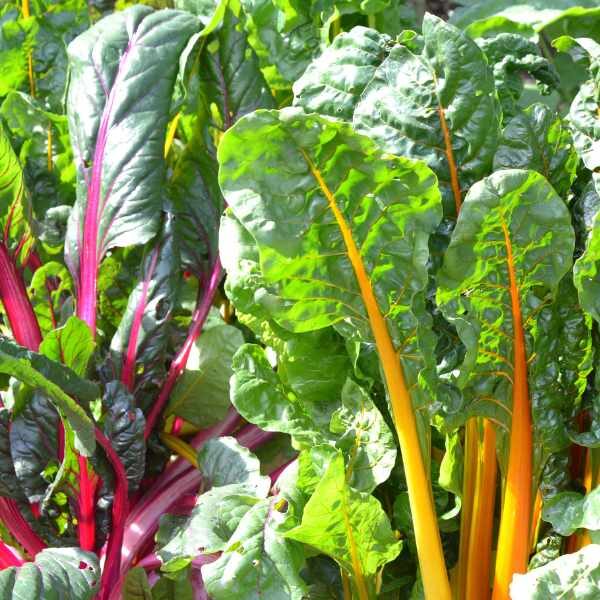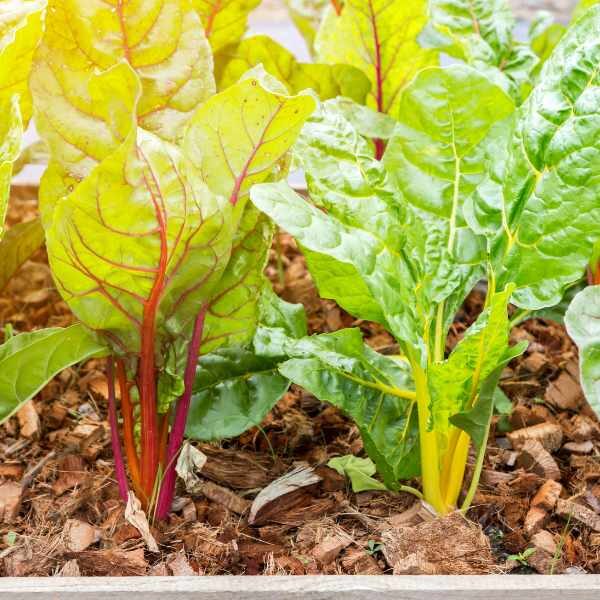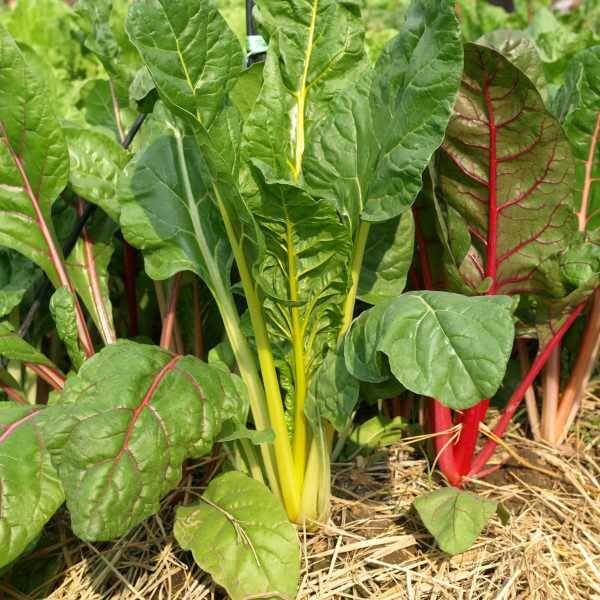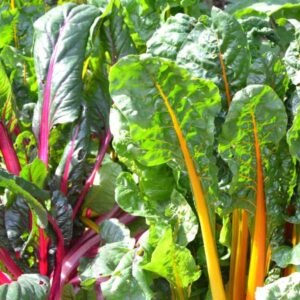Silverbeet Rainbow Chard
$4.95
Beta Vulgaris
- Seed Count 50
- Mix of yellow, white, pink and red
- Hardy Biennial
In stock
Description
Silverbeet Rainbow Chard with stems that blaze in hues of red, pink, golden orange, and yellow, is as much a feast for the eyes as it is for the plate. But don’t let its looks fool you; beneath that showy exterior lies a hardy, versatile green that’s as practical as it is pretty.
The young leaves, harvested early, make a mild addition to salads, their texture delicate and their flavour fresh. Left to mature, they develop a deeper, more robust taste, ideal for wilting into stir-fries, soups, or sautés. The stems, often overlooked in other greens, are a standout here: sliced thinly, they add a bright, juicy crunch to raw dishes, or when cooked, a subtle sweetness.
While it thrives in temperate conditions, it’s remarkably forgiving across Australia’s varied climates. From the cooler south to the subtropical north, this plant persists, though it appreciates a little respite during the fiercest summer heat. A bit of shade during midday sun, or strategic planting to avoid the harshest months, keeps it producing lush growth even when temperatures climb. It’s the kind of crop that suits both the meticulous gardener and the casual grower – low fuss, high reward.
Nutritionally, it’s a powerhouse. Packed with vitamins A, C, and K, along with minerals like magnesium and iron, it’s a leafy green that delivers more than just flavour. The colourful stems aren’t just for show, either; those pigments signal the presence of antioxidants and phytonutrients, compounds that support overall health. Whether you’re tossing it raw into a lunchtime bowl or simmering it into a hearty dinner, this is a vegetable that nourishes as it satisfies.
| Method: Sow direct | Soil Temp: 10°C - 30°C |
| Cool Mountain: Sep - Mar | Position: Part sun |
| Arid: Jan - Dec | Row Spacing: 30cm apart |
| Temperate: Sep - May | Planting Depth: 10mm |
| Sub Tropical: Jan - Dec | Harvest: 60 days |
| Tropical: Apr - Jul | Plant Height: 40cm |
Basics
- Capsicum (sweet/bell Capsicum) thrives in warm, sunny gardens.
- Plant them in a spot with full sun (6+ hours) and rich, well-drained soil.
- Prepare the bed by removing weeds and digging in plenty of compost or aged manure.
- Use mulch around plants to retain moisture and suppress weeds.
Seed Trays vs Direct Sowing
Seedling Trays:
- Raise seeds in pots or trays filled with seedling mix, keeping them warm (16-35°C) and moist.
- This protected start speeds germination and gives plants a head start on weeds and weather.
- You’ll use fewer seeds and get sturdy seedlings for an earlier crop.
- The downside is extra effort and cost (pots, mix, heat source) and you must harden-off seedlings before planting out.
Direct Sowing:
- Plant seeds 3mm deep in the garden soil 50cm between plants, 60–100cm once it’s warm and frost-free.
- Direct sowing is simpler and cheaper (no trays or special mix), but germination is slower and more vulnerable to cold, pests or heavy rain.
- Capsicum seeds can take 1–3 weeks to sprout at 16–35°C.
- Ensure the soil stays evenly moist (not waterlogged) during this time.
In short: use trays if you want the best germination and an early start; sow direct if you prefer simplicity and have already warm conditions.
Planting and General Care
Timing & Spacing:
- Plant or transplant capsicum after all danger of frost has passed.
- In tropical/subtropical areas, Capsicums can even fruit year-round, but in cooler zones treat them as an annual summer crop.
Soil:
- Use well-drained, fertile soil rich in organic matter.
- Work in compost or aged manure before planting.
- Capsicums prefer a slightly acidic to neutral pH (~6.0–7.0).
- In pots, use at least ~40L per plant.
Watering:
- Water deeply and regularly, so the soil stays evenly moist.
- Check soil moisture by pushing a finger 4–5cm down; water when that layer is just dry.
- Water in the early morning or late afternoon to minimize stress.
- Avoid wetting the leaves, which can encourage fungal disease.
- Mulch around plants to keep roots cool and reduce evaporation.
Fertilising:
- If the soil was well-prepared, you may need little extra feed.
- Otherwise, apply a balanced (e.g. 10-10-10 NPK) slow-release fertilizer at planting.
- Once flowers and fruit start, give a liquid tomato or vegetable fertilizer every few weeks according to label directions.
- This supports heavy fruiting. Avoid excessive nitrogen late in the season, as it can reduce fruit set.
Staking & Pruning:
- Capsicum plants can get top-heavy with fruit. Stake or cage them when planting.
- A simple sturdy stake beside each plant works – gently tie the main stem (e.g. with soft string) as it grows.
- This prevents wind damage and keeps fruit off the ground.
- Remove any low or damaged leaves to improve air flow.
- Many gardeners also pinch out a few early flower buds when plants are young – this encourages stronger vegetative growth and heavier later yields.
- Overall, little pruning is needed beyond this.
Pest & Disease Management:
- Monitor plants for pests like aphids, caterpillars, slugs/snails, and chilli thrip.
- Hand-pick pests or use organic sprays if needed.
- Practice good hygiene: remove weeds and crop debris.
- Rotate capsicum/solanaceous crops to a different spot each year to reduce disease pressure.
- Common diseases include blossom-end rot (from inconsistent watering or low calcium) and fungal spots.
- Regular watering and mulch help prevent blossom-end rot.
- Crop rotation and not overcrowding plants also reduce problems.
Chilli Thrips: What They Are & How to Deal With Them
- Chilli thrips (Scirtothrips dorsalis) are tiny, slender insects that can cause big problems in home veggie patches—especially for capsicum, chilli, eggplant, and tomato plants.
- You might not see them easily (they’re less than 2mm long!), but the damage is easy to spot as leaves curl or look bronzed and scarred, buds drop off, and fruit can become deformed or scarred.
- These pests feed by piercing plant tissue and sucking out the juices, which leads to silvery or brown patches on leaves and distorted growth.
- They tend to hang out on the newest growth, flower buds, or the undersides of leaves—so grab a magnifying glass and check these spots first if your plants are looking stressed.
What You Can Do:
Prevention is key:
- Start clean – Avoid bringing in infested seedlings or cuttings.
- Attract beneficial bugs like lady beetles, lacewings, and predatory mites—they’ll help keep thrip numbers down.
- Plant flowers like alyssum, marigold, or dill nearby to draw in the good guys.
If they show up:
- Prune affected areas early to stop the spread.
- Hose them off gently with water to dislodge thrips from foliage.
- Apply insecticidal soap or horticultural oil, covering all leaf surfaces, especially underneath. Repeat weekly as needed.
- Rotate your crops each year to disrupt their lifecycle.
Tip: Thrips love hot, dry conditions—so keep your plants well-watered and mulched to reduce stress and deter infestations.
Companion Planting with Capsicum
Good companions:
- Herbs & Flowers: Basil, dill, parsley, coriander, chamomile and other aromatic herbs as they attract beneficial insects and may repel aphids or whiteflies. Garlic, onions, chives as their strong scent deters many pests. Marigolds, nasturtiums, borage, lavender as these flowers lure pollinators and trap pests (marigolds are famous for nematode control).
- Vegetables: Carrots, lettuce, spinach as they occupy shallow roots and don’t compete much with Capsicums. These can provide light ground cover under Capsicum plants. Tomatoes are sometimes planted alongside Capsicums (both like similar conditions) but be aware they share some pests/diseases so give them space and rotate beds regularly.
- Fruits: Strawberries and cucumbers have been noted as decent neighbours (shallow roots and shade from cucumber leaves can protect Capsicums).
Bad Companions
- Other heavy feeders or close relatives.
- Do not grow next to eggplants, potatoes or tomatoes in succession, as they share pests/diseases.
- Stay away from beans/peas and plants like fennel or dill, which can inhibit Capsicum growth.
- Squash and pumpkins (deep-rooted cucurbits) can out-compete Capsicums for nutrients.
- In short, pair Capsicums with light-feeders and pest-deterring plants, and keep them apart from other nightshades and big gourds.
Seed Saving
Saving your own Capsicum seeds is easy if you follow a few simple steps:
Select plants:
- Pick the healthiest plants with strong, typical fruit.
- If growing multiple types, isolate them (e.g. bag flowers or keep 20m+ apart) to prevent cross-pollination.
Harvest ripe fruits:
- Wait until Capsicums are fully ripe on the plant which is usually when they’ve changed to their final colour and just start to soften or wrinkle.
- Allowing fruits to over ripen a little ensures the seeds are mature.
Extract seeds:
- Cut the Capsicum in half and scoop or twist out the central core.
- Scrape out the seeds and remove as much of the inner flesh and pith as possible.
- Rinse the seeds in clean water to wash off any remaining pulp which helps them dry cleanly.
Dry seeds:
- Spread the seeds in a single layer on paper towels or a clean plate in a dry, shaded place.
- Let them dry completely over several days.
- They’re ready when you can crunch a seed in your fingers and it snaps rather than bends.
- Moisture is the enemy of seed storage, so make sure they feel fully dry.
Store seeds:
- Transfer the dried seeds to a paper envelope or small jar with a tight lid.
- Label with variety and date.
- Store in a cool, dark, dry spot (a refrigerator works well).
- Properly stored Capsicum seeds remain viable for about 3–4 years, so you’ll have plants for many seasons.
Climate and Timing:
- Ideal Regions: Silverbeet flourishes in temperate to cool regions. It can tolerate heat but prefers a cooler growing period.
- Seasons for Planting:
- Cooler Areas: Sow seeds from early spring to summer.
- Warmer Areas: Sow seeds in autumn and avoid the hottest summer months to prevent bolting.
Soil Preparation:
- Soil Type: Prefers fertile, well-drained soil with good organic content. Ideal soil texture is sandy loam or loamy soils.
- pH Levels: Aim for a pH of 6.0 to 7.0. Conduct a soil test, if possible, to determine required amendments.
- Soil Preparation Steps:
- Clear the area of debris and weeds.
- Incorporate organic matter such as compost or well-rotted manure to enrich the soil.
- Break up any large clumps and ensure good aeration.
Planting:
- Seed Starting:
- Seeds can be sown directly in the garden or started indoors for later transplanting.
- Plant seeds 1 cm deep.
- Spacing:
- Space seeds or seedlings about 30 cm apart to allow for mature growth.
- For a continuous harvest, you may stagger planting every few weeks.
Care and Maintenance:
- Watering:
- Maintain consistent moisture, especially in dry spells. Water deeply to encourage deep root growth; avoid waterlogging.
- Mulch around the plants to retain moisture and suppress weeds.
- Fertilisation:
- Use an all-purpose organic fertiliser every 4-6 weeks during the growing season to promote strong leaf growth.
- Pruning and Harvesting:
- Pick outer leaves as needed, allowing the inner leaves to continue growing.
- Regular harvesting promotes bushier growth and can extend the harvesting period.
Pests and Diseases:
- Common Pests:
- Aphids: Small insects that can cluster on leaves. Control with neem oil or insecticidal soap.
- Slugs and Snails: Manually remove or use organic barriers.
- Caterpillars: Hand-pick or use organic sprays to deter them.
- Diseases:
- Watch for downy mildew and rust. Ensure good air circulation and avoid overhead watering to reduce humidity on foliage.
Companion Planting
Good Companion Plants:
- Onions and Garlic: Strong scents repel aphids and other pests, protecting Silverbeet from infestations.
- Carrots: They do not compete heavily for nutrients and can help aerate the soil with their roots.
- Beets: Being from the same family, they often flourish together, utilizing similar nutrients effectively.
- Basil: Enhances the flavour of Silverbeet and can deter some pests.
Plants to Avoid:
- Pole Beans and Peas: These can attract pests that might also harm Silverbeet and compete for nutrients.
- Potatoes: They are susceptible to similar diseases and can hinder Silverbeet growth.
- Corn: Can shade Silverbeet and lead to inadequate light for optimal growth.
Additional Tips:
- Crop Rotation: Practice crop rotation to prevent nutrient depletion and reduce the risk of soil-borne diseases.
- Succession Planting: Plant Silverbeet in succession for continuous harvesting. This means sowing seeds every 2-3 weeks.
- Harvesting: Always harvest in the morning for the best taste and texture, removing only what you need to encourage continued growth.
Postage Charge
Orders under $30 attract a $4.95 shipping charge. Orders $30 and above have free shipping.
Order Times
Seed orders are normally dispatched within three business days. You will receive an email when seeds are mailed out.
Postage Days
Seeds are mailed out Monday to Friday at 1pm. Except for the Friday of long weekends.
Postage Times
WA 2-3 Days: SA,NT 3-5 Days: NSW, ACT, QLD, VIC: 5-7 Days
Carrier
We use Australia Post Letter Postage for the majority of orders
Not only are our seeds packed in recycled paper envelopes, we keep the theme going when we post out website orders. To protect your seeds from moisture and the letter box munchers (snails), we use a very special plastic free material made from plants. They are then put into recycled mailing envelopes. Green all the way 💚🌿
















Reviews
There are no reviews yet